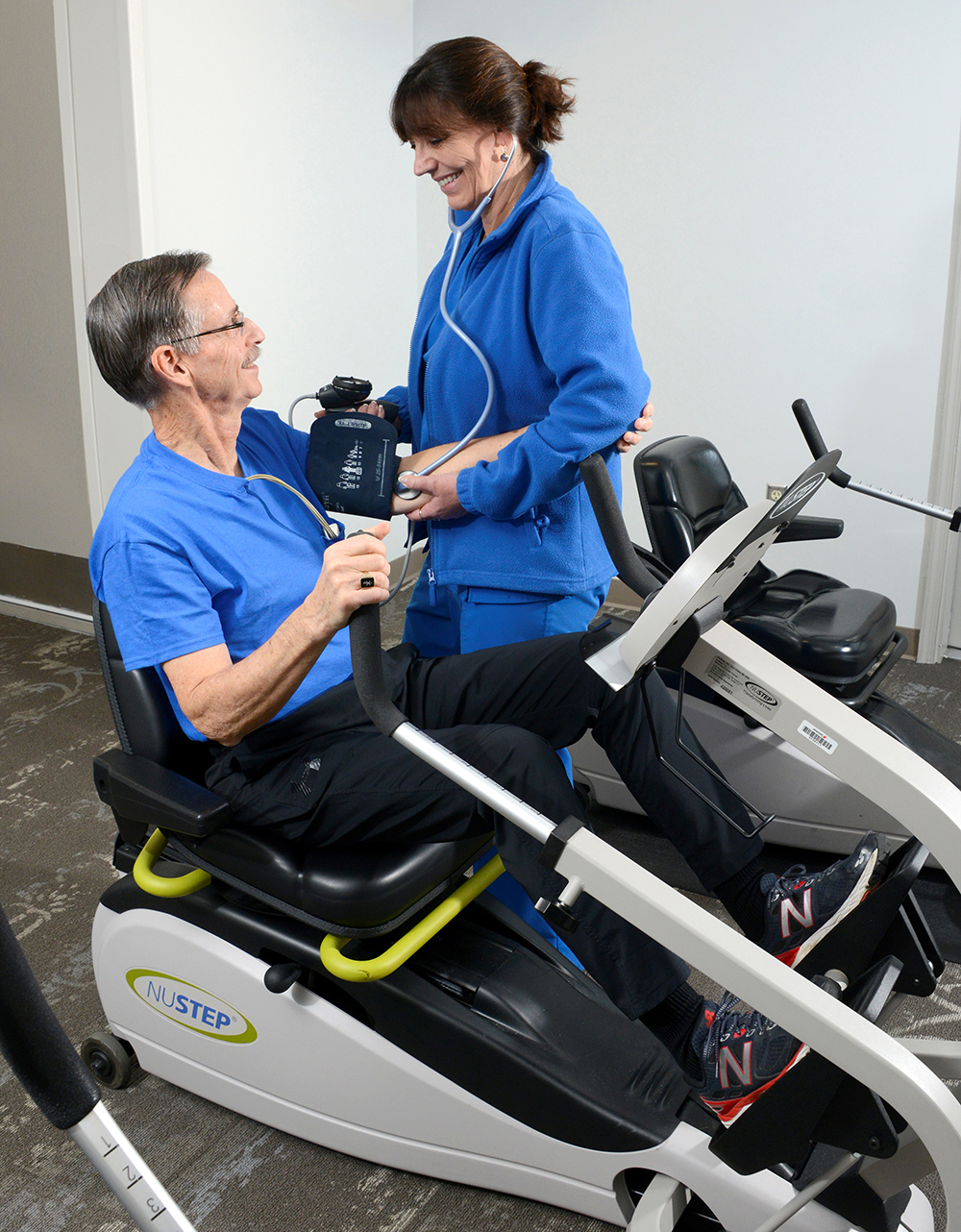“Nine out of 10 cardiac rehabilitation patients I see are very scared before they start,” said Mary Bahen, RN, who coordinates the nationally accredited program at CalvertHealth Medical Center. “They’re afraid to move because they’re worried they’ll hurt their heart.”
According to Bahen, one of the program’s main goals is to teach patients who have survived a heart attack or heart surgery how to exercise safely and confidently so they will continue on their own after they leave the program.
“We help them learn how to listen to their body,” said Bahen, “so, they know they are working at the right intensity for their heart to get the optimal benefit from the exercise.”
The 12-week program, which is covered by most insurance policies, includes monitored exercise three days a week and is designed around each patient’s personal needs and physical condition. Nutrition counseling is offered along with education about how to modify risk factors.
Making Healthy Lifestyle Changes
“You learn very quickly you need to change the way you think and act,” said Paul Liersemann, 70, of Prince Frederick. “You can’t continue to do what you’ve always done.”
The retired military chaplain had a TIA (transient ischemic attack), followed by a stroke and then a heart attack in 2016. He used to work up to 65 hours a week, skipped lunch and was under a lot of stress.
“I realized I could have a healthier lifestyle than before if I just listened and followed what my doctors and healthcare providers told me,” said Liersemann. Today, his life is much different.
“I walk three to five times a week with a friend who encourages me and keeps me accountable. I do 30 pushups every morning. I try to use an elliptical trainer three times a week when I’m home, and I go swimming with my wife at the aquatic center,” said Liersemann.
There have been other changes, too. “I drink more water. I go to bed and get up at the same time every day. Take a power nap in the afternoon when I can and eat regular meals. I don’t feel 70. I feel 50, maybe 45,” he added with a smile.
According to Bahen, patients who complete the program consistently demonstrate significant improved functional capacity. “They’re able to walk up stairs more easily, do housework without getting out of breath and are able to increase their activity level,” she said.
Monitoring Enhances Secure Feeling
“After I had SCAD (spontaneous coronary artery dissection), I was scared of becoming active,” said Susan Wilding, 48, of St. Leonard, who used to run to stay healthy. The rare, sometimes fatal condition occurs when a tear forms in one of the blood vessels in the heart.
“In cardiac rehab, I learned to trust again,” said Wilding. “It was the security of being watched and the constant monitoring.” Wilding, a middle school teacher, was able to attend the program before work.
She credits the cardiac rehab program with getting her back on track. The busy mother of three continues to exercise three times a week. “I’m not where I want to be with my weight but I’m making better choices with my eating and exercising regularly,” she said. “I’m really grateful I get to lead a healthy life.”
Positive Outlook Without Worry
“I learned so much,” said Cathy Gallihugh, 68, of Huntingtown, who attended cardiac rehab after she had a quadruple bypass. “They retrain the way you breathe to get the maximum benefit from exercise,” she said. “You learn how far to push yourself to keep getting stronger on your own. I still rely on that information.”
The retired school teacher and grandmother of two said, “It made a huge difference in my outlook after I was done with the program. It’s very freeing not to have to walk around worried.”
How Much Physical Activity Do We Need?
Being physically active is important to prevent heart disease and stroke. To improve overall cardiovascular health, the American Heart Association (AHA) recommends adults get:
- At least 30 minutes of moderate-intensity aerobic activity (walking, jogging, swimming or biking) at least 5 days per week for a total of 150 minutes, or
- At least 25 minutes of vigorous aerobic activity at least 3 days per week for a total of 75 minutes or a combination of both, and
- Moderate to high-intensity muscle-strengthening at least 2 days per week for additional health benefits
The easiest change you can make to effectively improve your heart health is to start walking today. Even if you can’t make it for 30 minutes, start with what you can do and gradually increase your time as you get stronger.

Paul Liersemann, 70, of Prince Frederick, embarked on a healthier lifestyle with the help of CalvertHealth’s cardiac rehabilitation program following a stroke and heart attack in 2016. “I don’t feel 70. I feel 50, maybe 45.”